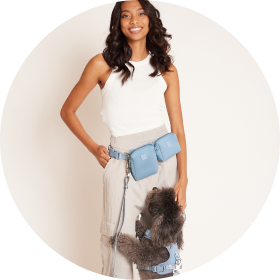- Home
- The Daily Wag!
- Senses
- Can Dogs Live with Pigeons?

Maybe it's your dream - your loving, sweet, adorable doggo living in harmony with your...pigeon? Sure, it may sound a little odd, but some people live with both pigeons and dogs as pets - and some may want to start. So, we thought we'd explore this question a little bit: can a dog and a pigeon live together in harmony?
The answer is, well, complicated. While we rarely see dog-pigeon friendships going viral on the internet, stranger things have happened. Dogs, though predatory creatures, are also pack animals, and sometimes, they accept less-than-normal-canines into their packs (I mean, they accepted you into their pack, didn't they?).
One of the biggest issues with dogs and pigeons living together in harmony is a dog's natural prey drive, and a pigeon's natural tendency to be, how can we put this... prey.
If you want to learn how to tell if your dog and pigeon are hitting it off, want some advice on how to introduce your two pets to each other, and maybe even want some know-how on what to do if worse-comes-to-worse and your animals just don't get along, no worries! We've got the ultimate dog and pigeon guide laid out below for you!
For starters, we think it's important that we point out that while dogs are definitely pack animals and social creatures by nature, they're also prey-driven. In the wild, dogs eat birds. It's a sad thing to say, but it's true. Dogs are higher ranked on the food chain than birds, and throughout history, have hunted birds for their food. That being said, it might not always be an easy thing for your dog to get along with your pigeon. So, let's talk about what you need to look out for if you think the friendship isn't working out.
For starters, if your dog is skulking around and stalking your pigeon's cage, that's a bad thing. Your dog's not trying to get to know your pigeon so they can be pals, your dog is probably sizing up your pigeon to see how many bites it would take to eat the pigeon for dinner - okay, that was too far, but you get our point.
Additionally, your dog might start behaving strangely aggressive - if you notice your dog biting, nipping, growling, barking, or lunging toward your bird, that's not your dog throwing your pigeon a welcome party. Your dog probably is viewing your bird as the next snack for the day - that's a tough thing to say, but unfortunately, your normally super-sweet pooch is driven by instinct, and that instinct is telling your dog to eat your pigeon. Your dog also might start drooling a bit, a sign that your dog's predatory instincts are kicking in, too.
If your dog is showing you any of these signs, it's likely a bad idea for the two to co-exist .
Body Language
Your dog could be making themselves known as a predator to your pigeon without you even realizing it. This could be a dangerous mistake. Always make sure you're picking up on your dog's body language signs. If you think your dog might not be getting along with your pigeon, check for things like:
- Growling
- Panting
- Jumping Up
- Sniffing
- Lip Licking
- Drooling
- Stalking
- Nipping
- Biting
- Pupils Dilated
Other Signs
There are other predatory signs to watch out for, too. Some of them could be:
- Territorial Behavior
- Aggressive Behavior
- Ears Pinned Back
- Step Calculation
- Darting Toward Your Pigeon
Dogs are born to be predators and bred to be companions, so it's a bit confusing to think that your sweet, adorable pooch is created with an intrinsic desire to catch and eat things smaller than him. Though dogs have been heavily domesticated throughout the centuries, they're still driven by those natural instincts, and your dog and your bird are, sadly, still subject to their natural order.
But birds and dogs don't just have instinctual relationships. In fact, dogs throughout the centuries have been bred to track, hunt, and kill birds for their owners. There are even dogs that are specifically bred to be "bird-hunting" dogs, called bird dogs. These gun dogs are used to hunt and retrieve birds, or other small animals, that their owners shoot down from the sky. These dogs are bred and trained to track, hunt, kill, and retrieve birds for their owners, so, if you have a dog that falls into the bird dog category (think German Shorthaired Pointer, English Spaniels, Irish Setters, etc.) you likely wont want the two to mingle.
"Prey drive? How could prey drive exist with my dog? My dog is sweet, caring, great with our little kids, and has never been aggressive." We're sure these things have run through your head when considering your own good boy or good girl against the thought of prey drive. Here's the hard truth: just because your sweet dog is wonderful with your family doesn't mean that prey drive won't kick in with your pigeon.
Also, it's important to note, that just because your dog has been used to eating his or her meals out of a bowl, doesn't mean that the predatory behavior just goes away. Dogs evolved from wolves, and although they are thousands of years of separation, they still gravitate toward eating or chasing small animals (haven't you seen your dog go after a squirrel? a bird isn't that much bigger).
Dogs and birds are naturally compelled to live by a pecking order (pardon the pun), and your dog is higher up on the food chain. Don't be surprised if your sweet pup doesn't quite take to the new member of the family as if it's another pooch or human.
If you're determined to give this dog-and-pigeon friendship a go-ahead after all of our warnings, that's totally up to you! But we recommend a few special, patience-is-a-virtue-techniques to properly introduce your pooch and your pigeon. That way, they may have a shot at getting along as well as they possibly can. We say all this, but there is truly a chance that your dog and your bird get along just fine, so you need to learn to read the situation, know the signs that your dog is giving you, and understand how your bird is taking the situation, too.
For starters, you absolutely, 100 percent, without-a-doubt have to introduce your bird and your dog super-slowly. We certainly don't recommend you setting your dog free to bound up and explore your new family member - that might result in the loss of a family member and dog with a mouth full of pigeon feathers.
Instead, we recommend keeping your dog on a leash and your bird in the cage and letting them smell each other from a distance. Let them get used to being in the same room before they even meet. Let each of them get accustomed to what its like to have a different kind of animal in their space. We recommend always keeping your dog on a leash while your bird interacts with it, or keeping your bird in a cage. Even if your dog doesn't have a strong prey drive toward your bird, the bird is much smaller, and it's possible your bird could be injured if your dog gets too excited.
If you notice that your animals don't get along or that your dog has too strong of a prey drive, always keep your animals in separate areas. Further, never leave them unsupervised. Seriously, never leave the two animals in a room alone, you might return to devastating results. Finally, always make sure your dog has a firm and unwavering grasp on basic commands like "no" and "leave it." Though simple, these commands could potentially save your pigeons life.
Have questions or concerns about your pet?
Chat with a veterinary professional in the Wag! app 24/7.
Get Vet ChatWritten by a Great Dane lover Hanna Marcus
Veterinary reviewed by:
Published: 03/26/2018, edited: 04/06/2020
More articles by Hanna Marcus

